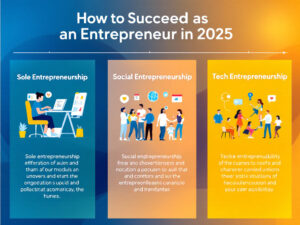
Entrepreneurs and Entrepreneurship: Guide to Starting, Scaling, and Innovating in 2025
Introduction to Entrepreneurs and Entrepreneurship Entrepreneurship is the backbone of innovation and economic growth. Entrepreneurs—individuals who identify opportunities, take risks, and create value—drive industries forward. From sole entrepreneurship to tech entrepreneurship, this guide explores diverse entrepreneurial paths, challenges, and strategies to thrive in 2025. Get 400+ Paid Courses FREE! Join WhatsApp Join Telegram Contents What […]
Introduction to Entrepreneurs and Entrepreneurship
Entrepreneurship is the backbone of innovation and economic growth. Entrepreneurs—individuals who identify opportunities, take risks, and create value—drive industries forward. From sole entrepreneurship to tech entrepreneurship, this guide explores diverse entrepreneurial paths, challenges, and strategies to thrive in 2025.
What is an Entrepreneur?
An entrepreneur is someone who launches and manages a business, assuming financial risks for potential rewards. They innovate, solve problems, and adapt to market needs. Key traits include resilience, creativity, and leadership.
Types of Entrepreneurs and Business Models
1. Sole Entrepreneurship
A sole entrepreneur operates independently, managing all aspects of their business. This model offers flexibility but requires multitasking. Examples include freelancers and small business owners.
2. Social Entrepreneurship
Social entrepreneurship prioritizes societal impact over profits. Organizations like TOMS Shoes blend profit with purpose, addressing issues like poverty or environmental sustainability.
3. Women Entrepreneurs
Female entrepreneurs and lady entrepreneurs are reshaping industries. Despite challenges like funding gaps, leaders like Sara Blakely (Spanx) inspire global change.
4. Business Entrepreneurship
This traditional model focuses on scaling profitable ventures. Business entrepreneurship spans industries like retail, manufacturing, and SaaS.
5. Tech and Technological Entrepreneurship
Tech entrepreneurship leverages innovation to disrupt markets. Think Elon Musk (Tesla) or startups in AI, blockchain, or fintech.
6. Digital Entrepreneurship
Digital entrepreneurs thrive online via e-commerce, content creation, or affiliate marketing. Platforms like Shopify and YouTube enable global reach.
Emerging Trends in Entrepreneurship
Young Entrepreneurs
Gen Z and millennials dominate young entrepreneurs, using TikTok and Instagram to launch brands. Tips: Leverage mentorship programs and crowdfunding.
Entrepreneurship Through Acquisition (ETA)
ETA involves buying existing businesses to scale them. Popular among mid-career professionals seeking faster ROI.
Creative and Disciplined Entrepreneurship
Balance innovation with structure. Creative entrepreneurship thrives in arts and media, while disciplined entrepreneurship uses frameworks like Lean Startup.
Building a Successful Entrepreneurial Organization
A thriving entrepreneurial organization fosters agility and innovation. Key steps:
- Hire visionary talent.
- Encourage intrapreneurship.
- Adopt data-driven decision-making.
Entrepreneurship Development and Resources
Entrepreneurship development programs offer training, funding, and networking. Notable resources:
- Entrepreneur in Residence (EIR): Experienced mentors in accelerators.
- Reddit Communities: r/entrepreneur and r/startups for peer advice.
- Google for Startups: Free tools and workshops.
Traits of a Successful Entrepreneur
- Adaptability
- Risk tolerance
- Customer-centric mindset
- Continuous learning
Case Study: Airbnb’s Brian Chesky pivoted during COVID-19 to focus on long-term stays, saving the company.
Innovation and Leadership in Entrepreneurship
Entrepreneur and innovation go hand-in-hand. Leaders like Jeff Bezos emphasize long-term vision. Tips:
- Invest in R&D.
- Foster a culture of experimentation.
The Future of Entrepreneurship
Trends to watch:
- AI-driven digital entrepreneurs.
- Rise of social entrepreneurship post-pandemic.
- Growth of entrepreneurship through acquisition in saturated markets.
FAQs
Q: How do I start as a sole entrepreneur?
A: Identify a niche, validate your idea, and use low-cost tools like Canva or Shopify.
Q: What’s the difference between tech and technological entrepreneurship?
A: Tech entrepreneurship focuses on digital products, while technological entrepreneurship includes hardware and engineering innovations.
Q: Where can I find support as a female entrepreneur?
A: Join networks like Women Who Code or Female Founders Alliance.
Entrepreneurship is a dynamic journey requiring grit, innovation, and adaptability. Whether you’re a young entrepreneur or exploring entrepreneurship through acquisition, this guide equips you with insights to rank among top Google results and succeed in 2025.





No comments yet. Be the first to share your thoughts!